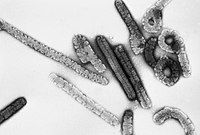
Photo from wikipedia
Dear Editor, An emergence of the novel coronavirus designated as the severe acute respiratory syndrome coronavirus 2 (SARS-CoV-2) at the end of 2019 has triggered an ongoing pandemic of coronavirus… Click to show full abstract
Dear Editor, An emergence of the novel coronavirus designated as the severe acute respiratory syndrome coronavirus 2 (SARS-CoV-2) at the end of 2019 has triggered an ongoing pandemic of coronavirus disease 2019 (COVID-19) globally. As of 22nd September 2020, more than 30,949,804 confirmed cases and 959,116 deaths have been reported worldwide (WHO, 2020). COVID-19 bears several pathological hallmarks including fever, breathing difficulty, bilateral lung infiltration, and death in the most extreme cases (Huang et al., 2020). Several anti-viral drugs have been used to target the SARS-CoV-2 infection. These drugs include remdesivir, ribavirin, penciclovir, lopinavir/ritonavir, chloroquine (Wang, Cao, et al., 2020). However, most of these medicines have limited efficacy to reduce the severity and, particularly the mortality of COVID-19 patients. In addition, some of them have serious side effects (Cao et al., 2020; Wang, Zhang, et al., 2020). The shortcomings of current medicines lead scientists and physicians to continuously look up for better remedies for COVID-19. Resveratrol is a promising one of those remedies. Resveratrol (3,4,5-trihydroxy-trans-stilbene, RES) is a phenolic compound produced by various members of spermatophytes such as grapes, mulberry, and peanuts. It displays potential effects to suppress replication of several viruses including dengue virus (DENV), Zika virus (ZIKV), as well as influenza virus (Mohd, Zainal, Tan, & Sazaly, 2019; Paemanee, Hitakarun, Roytrakul, & Duncan, 2018). Particularly, RES has the capacity to significantly inhibit MERS-CoV infection and increases the viability of cells infected by this virus (Lin et al., 2017). Based on these observations, we have initiated a study to test whether RES also inhibits the replication of SARS-CoV-2. This study has been approved by the ethics committees from Shenzhen Third People's Hospital and strictly follows the approved protocol. All procedures involving SARS-CoV-2 infection were performed in a biosafety level 3 laboratory. First of all, the dose-responsive study of RES (from 1.56 to 200 μM) was performed to assess whether RES exhibits cytotoxicity on Vero cells (ATCC, CCL-81). The results showed that cell viability of Vero cells remained above 90 and 80% with the RES at concentrations of 100 and 200 μM for 48 hr, respectively (Figure 1a). The results suggested that RES had little cytotoxicity to Vero cells even at such high concentrations which is consistent with previous reports on various other cell types including oocytes or embryos (Li et al., 2016). To test the effects of RES on SARSCoV-2 replication, the Vero cells were infected with SARS-CoV-2 (BetaCoV/Shenzhen/SZTH-003/2020 strain virus GISAID access number: EPI_ISL_406594) at a multiplicity of infection (MOI) of 0.01 and treated with different concentrations of RES. The viral replication was analyzed at 48 hr postinfection with quantitative reverse transcription polymerase chain reaction (qRT-PCR) and immunofluorescence assay (Figure 1b,c). The results showed that RES significantly inhibited the replication of SARS-CoV-2 with an EC50 (half-maximal effective concentration) of 4.48 μM. To examine the time window of RES on SARS-CoV-2 infection, RES was incubated with cells before and/or after their infection and the time-of-addition assay was used to evaluate the effects described by Wang, Cao, et al. (2020). Briefly, viral RNA was extracted from the harvested supernatants and then qRT-PCR was performed. The SARS-CoV-2 mRNA copy number was compared between the mock-treated and RES-treated cells. The results showed that the inhibitory rate for SARS-CoV-2 replication in cells pre-treated with RES 50 μM for 2 hr was less than 20%; however, inhibitory rate in cells treated with RES after virus infection was excessive at 98% which was similar to the full time treatment (pre and after treatment together). The results indicate that the inhibitory effects of RES on SARS-CoV-2 replication have a strong presence after the viruses are inoculated into the culture medium. It has been reported that RES possesses highly stable conformation to the viral S protein-ACE2 receptor complex (Wahedi, Ahmad, & Abbasi, 2020). Interestingly, when cells were co-incubated with virus and RES for 1 hr and then the RES was removed for additional 48 hr incubation, the inhibitory rate was still at around 64% (Figure 1d). This suggests that RES has a blocking capacity to the viral entry into cells. These novel data support the potential utility of RES on SARS-CoV-2 infection. RES activates intracellular SIRT1 signaling which plays an important role in the resistance of viral infection (Côté et al., 2015). Therefore, a SIRT1 antagonist, Sirtinol, and a SIRT1 activator, SRT 1720, were selected to test whether RES inhibited SARS-CoV-2 infection via SIRT1 pathway. The results showed that Sirtinol indeed promoted the replication of SARS-CoV-2 while SRT 1720 seemed to have little effect on virus replication (Figure 1e). Judging from the effect of Sirtinol on replication of SARS-CoV-2, additional SIRT1 activators should be used to further explore the mechanism. RES has been reported to decrease the production of nitricoxide in tissue, and thereby to reduce the tissue inflammatory reaction. RES also acts as an antioxidant to scavenger-free radicals to restrain tumor growth and even age-related diseases. As a naturally occurring Received: 14 September 2020 Revised: 22 September 2020 Accepted: 25 September 2020
Journal Title: Phytotherapy Research
Year Published: 2020
Link to full text (if available)
Share on Social Media: Sign Up to like & get
recommendations!